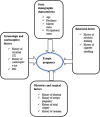Magnitude of ectopic pregnancy, management methods, and its associated factors among pregnant women attending Ambo University Referral Hospital in Oromia Regional State, Ethiopia: A seven years retrospective institutional based cross-sectional study
- PMID: 40471945
- PMCID: PMC12140202
- DOI: 10.1371/journal.pgph.0004611
Magnitude of ectopic pregnancy, management methods, and its associated factors among pregnant women attending Ambo University Referral Hospital in Oromia Regional State, Ethiopia: A seven years retrospective institutional based cross-sectional study
Abstract
Background: Ectopic pregnancy is the implantation of a blastocyst outside of the endometrial lining of the uterus. Ectopic pregnancy can take several forms, including ovarian, abdominal, and tubal. The most prevalent place for ectopic pregnancy is the fallopian tube, which accounts for over 97.7% of all ectopic gestations. The ampulla accounts for around 80% of tubal pregnancy, followed by the isthmus (12%), fimbria (5%). Ectopic pregnancy is diagnosed with the classic triad of amenorrhea, abdominal pain, vaginal bleeding, and a positive pregnancy test.
Objective: This study aimed to assess the magnitude of ectopic pregnancy, its management outcome, and associated factors among pregnant women attending Ambo University Referral Hospital in the Oromia Region, Ethiopia, in 2024.
Methods: A seven-year retrospective cross-sectional study, from February 2018 to April 2024, was conducted at the Ambo University Referral Hospital, which is located in Ambo town, Ethiopia. Data concerning all pregnant mothers who were admitted and managed for ectopic pregnancy were extracted from the medical records of patients and the operation book by a trained data collector through Kobo Toolbox electronic data collection software. The collected data was checked first for its completeness, and it was exported into SPSS version 26 software for data analysis. Then Descriptive statistics were employed for summarizing the data, and bivariate and multivariate logistic regression analyses were used to identify the independent effect of the predictor variable on the outcome variable.
Results: From February 2018 to April 2024, there were 17,687 total pregnancies, 6,249 gynecologic admissions, and 182 cases of ectopic pregnancies at Ambo University Referral Hospital. A total of 173 patients with ectopic pregnancy were included in the data analysis. The magnitude of ectopic pregnancy was 0.98% among the total pregnancies and accounted for 2.77% of all gynecological admissions during the study period. Most of the patients, 81 (46.8%), were in the 25-29 years age group, with a mean age of 27.16 ± SD 4.77 years. Mothers who had a previous history of abortion, a history of pelvic inflammatory disease, a history of ectopic pregnancy, or a history of tubal surgery had a statistically significant association with ectopic pregnancy. The majority of the patients were married, 98 (56.6%), and urban residents, 121 (69.9%). The majority of ectopic pregnancies occurred on the right side of the fallopian tube 144 (83.24%). Among the majority of ectopic pregnancies, 159 (61.3%) were tubal ampullary ectopic pregnancies.
Conclusion and recommendation: The major risk factors identified in this study were previous abortion, pelvic inflammatory disease, a previous history of ectopic pregnancy, and previous tubal surgery. The magnitude of the ectopic pregnancy in this study was 0.98%, which is similar to the global range. The majority of ectopic pregnancies occurred on the right side of the fallopian tube 144 (83.24%) and 160 (92.49%) were ruptured. Further research is needed to assess why ectopic pregnancy is most common in the right fallopian tube.
Copyright: © 2025 Gizaw et al. This is an open access article distributed under the terms of the Creative Commons Attribution License, which permits unrestricted use, distribution, and reproduction in any medium, provided the original author and source are credited.
Conflict of interest statement
The authors have declared that no competing interests exist
Figures







Similar articles
-
Determinants of ectopic pregnancy among pregnant women attending referral hospitals in southwestern part of Oromia regional state, Southwest Ethiopia: a multi-center case control study.BMC Pregnancy Childbirth. 2021 Feb 12;21(1):130. doi: 10.1186/s12884-021-03618-7. BMC Pregnancy Childbirth. 2021. PMID: 33579224 Free PMC article.
-
Ectopic Pregnancy in Tigray, Ethiopia: A Cross-Sectional Survey of Prevalence, Management Outcomes, and Associated Factors.J Pregnancy. 2021 Nov 30;2021:4443117. doi: 10.1155/2021/4443117. eCollection 2021. J Pregnancy. 2021. PMID: 34888104 Free PMC article.
-
Tubal conservation with ectopic gestations. A reappraisal.Am Surg. 1984 Apr;50(4):222-4. Am Surg. 1984. PMID: 6231872
-
Three consecutive recurrent ectopic pregnancies.East Afr Med J. 1993 Sep;70(9):592-4. East Afr Med J. 1993. PMID: 8181445 Review.
-
The rise in ectopic pregnancy--exploration of possible reasons.Int J Gynaecol Obstet. 1982 Aug;20(4):341-50. doi: 10.1016/0020-7292(82)90066-2. Int J Gynaecol Obstet. 1982. PMID: 6127270 Review.
References
-
- Cunningham FG. Williams obstetrics. 26th ed. McGraw-Hill Education. 2022.
-
- Neelima B, Vanamala VG. Risk factors of ectopic pregnancy: a study in a tertiary care centre. Int J Reprod Contracept Obstet Gynecol. 2017;6(7):2858. doi: 10.18203/2320-1770.ijrcog20172589 - DOI
-
- Shaikh SB, Jampala S, Devi SS, Mallika M. A Study of Ectopic pregnancy in a Tertiary Care Teaching Hospital. Ind Jour of Obstet and Gyn Res. 2016;3(2):132. doi: 10.5958/2394-2754.2016.00036.9 - DOI
-
- Abebe D, Tukue D, Aregay A. Magnitude and associated factors with ectopic pregnancy treated in Adigrt hospital, Tigray region, Northern Ethiopia. Res Pharm Sci. 2017;7:30–9.
-
- Marwah S, Rani KU, Mishra A. An audit of extra-uterine pregnancy in a tertiary care facility in Northern India. Int J Reprod Contracept Obstet Gynecol. 2017;6(11):5025. doi: 10.18203/2320-1770.ijrcog20175020 - DOI
LinkOut - more resources
Full Text Sources
Miscellaneous
